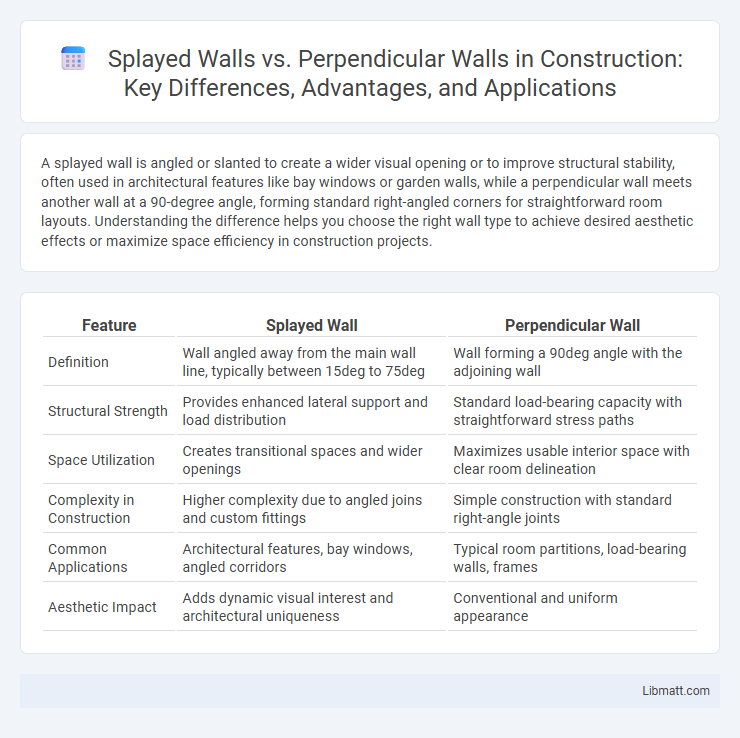A splayed wall is angled or slanted to create a wider visual opening or to improve structural stability, often used in architectural features like bay windows or garden walls, while a perpendicular wall meets another wall at a 90-degree angle, forming standard right-angled corners for straightforward room layouts. Understanding the difference helps you choose the right wall type to achieve desired aesthetic effects or maximize space efficiency in construction projects.
Table of Comparison
| Feature | Splayed Wall | Perpendicular Wall |
|---|---|---|
| Definition | Wall angled away from the main wall line, typically between 15deg to 75deg | Wall forming a 90deg angle with the adjoining wall |
| Structural Strength | Provides enhanced lateral support and load distribution | Standard load-bearing capacity with straightforward stress paths |
| Space Utilization | Creates transitional spaces and wider openings | Maximizes usable interior space with clear room delineation |
| Complexity in Construction | Higher complexity due to angled joins and custom fittings | Simple construction with standard right-angle joints |
| Common Applications | Architectural features, bay windows, angled corridors | Typical room partitions, load-bearing walls, frames |
| Aesthetic Impact | Adds dynamic visual interest and architectural uniqueness | Conventional and uniform appearance |
Introduction to Splayed and Perpendicular Walls
Splayed walls are angled or slanted walls designed to direct views or light, often used in architectural spaces to create a sense of openness and dynamic visual interest, while perpendicular walls meet at right angles, forming traditional, straightforward layouts that maximize space efficiency and structural stability. Architects choose splayed walls to enhance aesthetics and natural light penetration, whereas perpendicular walls are favored for their simplicity and ease of construction. Understanding the functional and design differences between splayed and perpendicular walls aids in optimizing building performance and spatial experience.
Definition of Splayed Wall
A splayed wall is an architectural feature where the wall surface is angled outward or inward rather than meeting at a perfect right angle, creating a wider or tapered opening. This design contrasts with a perpendicular wall, which intersects at a strict 90-degree angle, providing a straightforward and stable structural connection. Your building project may benefit from a splayed wall to enhance aesthetic appeal and natural light distribution by increasing aperture size without expanding the actual wall footprint.
Definition of Perpendicular Wall
A perpendicular wall is a vertical structure built at a 90-degree angle to an adjoining surface or floor, providing strong support and clear separation between spaces. This type of wall ensures maximum structural stability and efficient load distribution in building designs. Unlike splayed walls, which are angled and often used to redirect forces or create aesthetic effects, perpendicular walls serve as the fundamental framework in conventional construction.
Design Principles and Geometry
Splayed walls feature angled geometry that directs forces outward, enhancing stability by distributing loads more evenly compared to perpendicular walls, which form rigid 90-degree corners concentrating stress at joint intersections. Design principles for splayed walls prioritize optimizing the wall angle to maximize structural support and reduce shear stress, often used in retaining structures and architectural facades for both functional and aesthetic benefits. Perpendicular walls, grounded in orthogonal geometry, emphasize straightforward load transfer and construction simplicity, making them widely applicable in conventional building frameworks where right angles facilitate modular design and efficient material usage.
Structural Advantages of Splayed Walls
Splayed walls offer superior structural advantages over perpendicular walls by distributing lateral forces more evenly, enhancing resistance to wind and seismic loads. The angled design increases the base width, improving stability and reducing the risk of wall buckling under pressure. Your construction benefits from improved load-bearing capacity and enhanced durability in challenging environmental conditions with splayed walls.
Benefits of Perpendicular Walls
Perpendicular walls provide superior structural stability by evenly distributing loads and resisting lateral forces more effectively than splayed walls. They simplify construction processes, reducing material waste and labor costs due to straightforward alignment and standardized measurements. Enhanced interior space utilization and easier integration of fixtures make perpendicular walls advantageous for both residential and commercial building designs.
Aesthetic Applications in Architecture
Splayed walls enhance architectural aesthetics by creating dynamic visual interest and softening harsh angles, often emphasizing light and shadow interplay. Perpendicular walls deliver a clean, straightforward geometric form, providing a sense of order and stability essential for modern minimalist designs. The choice between splayed and perpendicular walls directly influences spatial perception and the emotional response evoked by the structure.
Construction Techniques and Challenges
Splayed walls require angled framing and precise measurement to ensure stability, often demanding custom-cut studs and specialized joinery compared to the straightforward right-angle construction of perpendicular walls. The unique geometry of splayed walls can complicate the installation of insulation, drywall, and finishes, increasing labor time and material waste. Understanding these challenges helps you plan effectively and allocate resources for a smoother build when working with non-perpendicular wall designs.
Energy Efficiency and Acoustic Considerations
Splayed walls enhance energy efficiency by increasing thermal insulation due to their angled surfaces, which reduce direct heat transfer compared to perpendicular walls. The angled design also improves acoustic performance by dispersing sound waves, minimizing echoes and reducing noise transmission more effectively than perpendicular walls. For your building, choosing splayed walls can optimize both energy savings and acoustic comfort in interior environments.
Choosing Between Splayed and Perpendicular Walls
Choosing between splayed and perpendicular walls depends on the desired aesthetic and functional requirements of your space. Splayed walls create a wider visual angle and can enhance natural light distribution, making rooms feel larger and more open. Perpendicular walls offer straightforward, space-efficient layouts ideal for traditional room designs and structural stability.
Splayed wall vs perpendicular wall Infographic

 libmatt.com
libmatt.com